By Vidya Rajan, Columnist, The Times
 I am currently in India. My father lives in Chennai, a city on the southeast Bay of Bengal coast, in a flat (apartment) in a tower block. Recently a swarm of honeybees showed up and settled on a large waterpipe that ran above a public stairwell. Anxious that passersby would get stung, a decision was made by the maintenance crew to call in pest control. A previous hive in the block had been sprayed and this was just another pesky bee problem.
I am currently in India. My father lives in Chennai, a city on the southeast Bay of Bengal coast, in a flat (apartment) in a tower block. Recently a swarm of honeybees showed up and settled on a large waterpipe that ran above a public stairwell. Anxious that passersby would get stung, a decision was made by the maintenance crew to call in pest control. A previous hive in the block had been sprayed and this was just another pesky bee problem.
One of the workers in the flats knew me and of my interest in honeybees. She hotfooted it to me and told me that there was a bee swarm and that pest control people going to come the following day. I went out to see the maintenance supervisor and asked him to show me the swarm. He did. It was impressive. The swarm was spread to 3 feet long and about 1 foot in height with thousands of bees.
They did nothing as I watched from just 3 feet away, marveling at the size of the bees. They were much larger than the European honeybee, Apis mellifera, that I was familiar with. And I felt a huge responsibility – without my intervention, these bees would die the next day. Then the maintenance supervisor walked me to another hive on the tower block roof– this was hanging above a courtyard, and the comb was monstrous – 3-4 feet in length and about the same in height. It was about 8 feet away from a window, the only access point. The signature of a previous comb was also visible along the edges of this hive; on being questioned, the maintenance supervisor told me that a previous hive had been sprayed. I knew all I needed to know. I asked the maintenance supervisor to not do anything for now, especially not to contact the pest control people. I would reach out to local beekeepers and see if someone would rescue these bees.

Older hive on underside of roof, and new swarm of A. dorsata on a water pipe in the apartment block in Chennai.
It was easier said than done to find local beekeepers. Search engines interrogated about “swarm” and “removal” spat out beekeeping clubs in Punjab – 1600 kilometers away – and the far south, but none in Chennai. After 20 minutes of trawling through articles like “Man dies after being stung by honeybees”, “Beekeeping comes of age” and honey sales sites, I decided to use “honeybee” and “Chennai” as the search terms. Gold. I got T. R. Apiary in Chennai’s Facebook page (maybe I should have searched for apiaries earlier!) No matter. I now had a phone number.
The phone was answered promptly. I explained the problem. The gentleman on the other end – T. Rajendran – asked me to show him the bees. So I switched to videochat and walked upstairs. After a few minutes of looking at the swarm, Rajendran told me that these were Apis dorsata and that no beekeeper would take them as they are aggressive and not domesticated. (Also known as the rock honeybee, each worker is about 1 inch long, only marginally smaller than Apis laboriosa, the Himalayan giant honeybee or cliff honeybee, which is the largest honeybee in the world at 1.2 inches in length. Their combs are typically attached to horizontal structures like the undersides of branches and roofs, and each comb typically grows to about 3 feet in horizontal dimension (length) and hangs about 2 feet in the vertical dimension (height), and to about 2 inches wide.) I told Rajendran they were going to be exterminated the following day if they were not saved. I also showed him the second hive. Rajendran told me he’d talk to a friend and call me back. He called back within the hour. His friend and he would come and remove the swarm, and knock down the other hive so the bees would fly away. But his friend was coming from a long way away – 400 km – so couldn’t be here until 2 days from now. But they would help save the bees. I was exultant! I asked Rajendran to bring me a veil so I could participate. He laughed and said I would need a bee suit, not just a veil for these bees, but that they would bring a spare.

Comparison of mounted workers of Apis cerana, A. mellifera and A. dorsata species. Image reproduced from https://bees4life.org/blog/beekeeping/8-honey-bee-species under fair use for educational purposes.
They duly showed up on Sunday. Rajendran’s friend, Vishnu, was a college buddy and an M.Sc. Biotechnology-trained farmer/beekeeper from Karur, 400 km south of Chennai. A message went out to the residents that the bee operation was taking place and to remain indoors. I supplied a ladder, a large breadknife and some large metal trays to put comb on. We got suited up. The beeks had brought neem branches twisted with dry coconut leaves to smoke the bees, two large baskets with vent holes and three or four plastic gunny sacks. The neem tree (Azadirachta indica) is a common tropical tree in the south of India. It has a slew of antimicrobial compounds, the most abundant of which is called azadirachtin. Neem extract finds its way into toothpaste, soaps, anti-lice treatment, organic plant pesticides, and its bitter flowers into food in South Indian cuisine. Neem branches are strung up during festivals, placed in water as a purifier, the twigs chewed as toothbrushes and waved as good luck charms. (No doubt we could use some luck!) The neem smoke caused the swarm some agitation and several of the massive bees flew towards me as I stood recording the event on my phone. They buzzed around me, hovered around me, and landed on me. They did not sting. Vishnu and Rajendran got up on ladders and scraped the first basket along the pipe, gathering up bees. A second basket was drawn along the pipe to gather up more bees. There were still about 5 pounds of bees flying around. So we left them to settle and headed down for lunch.
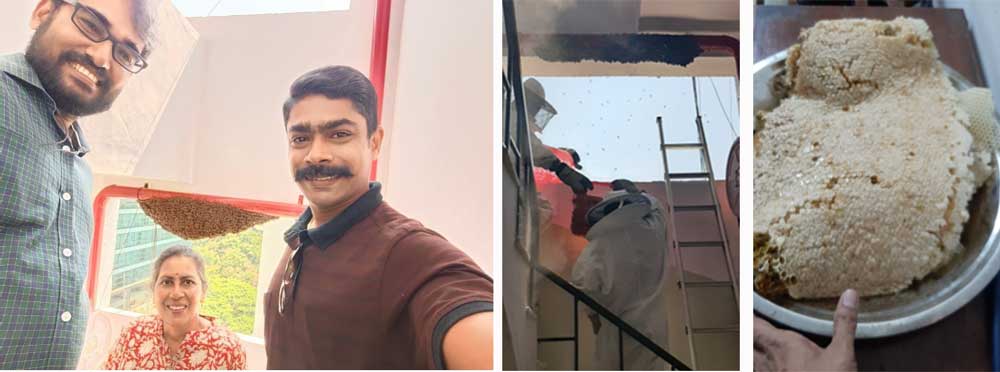
Left: Vishnu, me and Rajendran with the swarm in the background; Middle: Smoking the bees before scraping them up in perforated baskets. Right: A part of the brood comb of A. dorsata with my thumb for size comparison.
After lunch, we suited up again. To our unpleasant surprise, bees from one of the perforated baskets had escaped and restationed themselves on the pipe. The operation of smoking and capturing bees in the basket was carried out again, with discussions of making bee vacuums for future use. Meanwhile, the bees were not amused. They thudded against our clothing and delivered stings to the leather gloves. Vishnu later told me that older bees stung, whereas more recently hatched bees did not yet have enough venom for stinging and hitting the object as a warning was their method. Two baskets and three gunny sacks were filled with bees over the course of an hour. The swarm was mostly captured.
We moved on to the second location. This operation would require a long flexible roofing plank, shaped into a U, hoisted 10 feet out of the window. The hive would be smoked and the comb cut onto the plank using the breadknife tied to a long pole. The plank would be held at an angle that would (theoretically) cause the comb to slide towards us carrying a load of honey, and the bees would fly away to build somewhere else. The smoking went reasonably well, but bits of burning stuff fell on the plank. The first attempt to cut the comb was made. We watched breathlessly as the comb started leaning and then, wham! The comb fell on the plank. The comb was so heavy that the plank flexed the wrong way, like an umbrella catching the wind wrong, and we heard a massive splash as the comb hit the ground about 150 feet below. No further sound. I left Rajendran holding the plank and went downstairs to assess the damage. Two bemused onlookers were gazing at the huge 2×1 foot piece of comb that lay on the ground. A few disoriented bees were crawling around. I looked up and saw a huge chunk of comb sitting on a crossbeam above. The piece that had broken off had been larger than I had thought. After stationing a guard to tell people to stay out of the way, I went back up. We resumed the operation.
This time, we inserted a long metal ladder below the flexible roofing plank. Vishnu also cut smaller pieces of comb. But as the comb slid down, it gathered bees, bits of burnt leaves and whatever was already on the plank. The comb had lots of capped cells. There was a second comb hidden behind the first, and it looked like it was an outside comb and was beautiful and filled with capped honey. Vishnu started sawing with the knife, and suddenly the comb dropped, missing our plank by inches. Again, a wet flopping sound. I ran downstairs. The beautiful comb had exploded in a water gutter. There was honey seeping into the water and mud. It was unrecoverable. I went back upstairs and we all shook our heads sadly at the loss. The combs were down, and the bees were flying and settling where the combs had been. They would fly away, predicted Rajendran. He was right. They were gone the next day.
Meanwhile, we gathered up the swarm in its many bags and baskets – it must have weighed 20 pounds all told – and drove to Rajendran’s T.R. Apiary. My sister-in-law Vijaya, normally averse to bees, drove me and even ventured into the yard, shrinking a little when something buzzed past. While we waited for the day to cool and for the forest supervisor to okay the swarm’s release, we looked at the various bees and wasps that the T.R. Apiary held. There were three sizes of red paper wasps Rajendran had rescued from various locations (when people mistook the wasps for bees), several hives of the Asian honeybee A. cerana (a little smaller, but with equable temperament of A. mellifera) with the one oddity that all the drones were similar in size to workers and jet black, and all the workers banded like regular bees making it easy to tell them apart. Rajendran held an A. cerana bee out to Vijaya and it walked onto her hand – the first time she had voluntarily held a stinging bug! Progress!
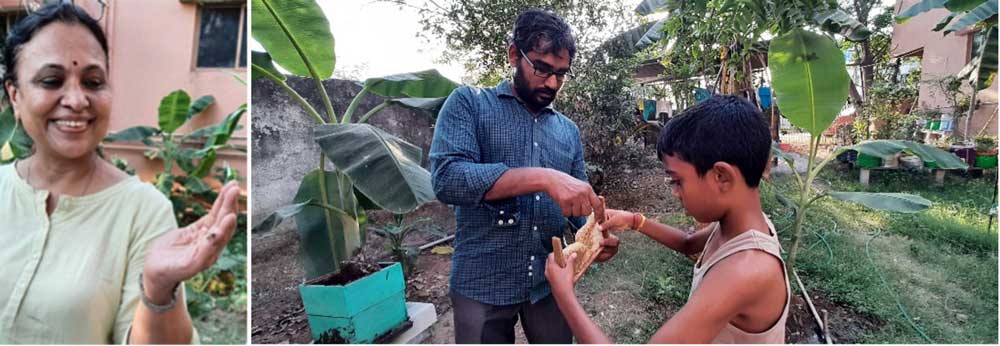
Left: Vijaya with A. cerana bee. Right: Vishnu and Rajendran’s son strap broken A. cerana comb into a frame.
There was a rescued hive of A. florea, an arboreal bee about two-thirds the size of A. cerana. These bees made their homes on branches of trees, putting a sticky substance on either end of the comb to trap ants that would otherwise overwhelm the hive. Then there was a small cluster of stingless bees – Tetragonula iridipennis – which stores its honey in gelatinous-looking goblet-shaped vessels around the sides of the brood comb. These tiny bees – about 5 millimeters long could not sting, but they were feisty and crawled all over Rajendran’s hand, biting mightily. He gently pulled them off and released them back into the tiny shoebox-sized hive. He told me these bees did not produce enough honey to remove, but that their presence was considered auspicious.

Left: Stingless T. iridipennis brood and stored honey. A few stingless bees can be seen on the board. Right: A. florea bees on a branch. The bees are being stored in a box before transport to their new home.
While we were walking around the apiary, what appeared to be a large dragonfly flew overhead. I called Vishnu and Rajendran’s attention to it. They laughed. That was no dragonfly – that was a giant Asian hornet! It supposedly had a pretty vicious sting. Vishnu was educating people about the importance of these otherwise fearsome insects, traveling around the state to save them, as he had to save these rock honeybees. Regular bee suits were hopeless for stopping these stings. He shared with me that he had ordered a hornet suit from the US through Amazon, but delivery was aborted for reasons that were not clear. (I will look into it, but I wonder if export controls cover hornet suits?) On the upside, his mission to rescue stinging insects was helped by rural Indian people’s general veneration for living things, with killing things only as a last resort. Urban dwellers are less in contact with nature, and generally frightened of stinging, flying, biting and crawling things. But with India’s population growing, communities were building further and further out into rural areas, bringing with them their intolerance. We all shook our heads sadly, including my sister-in-law. One convert at a time.
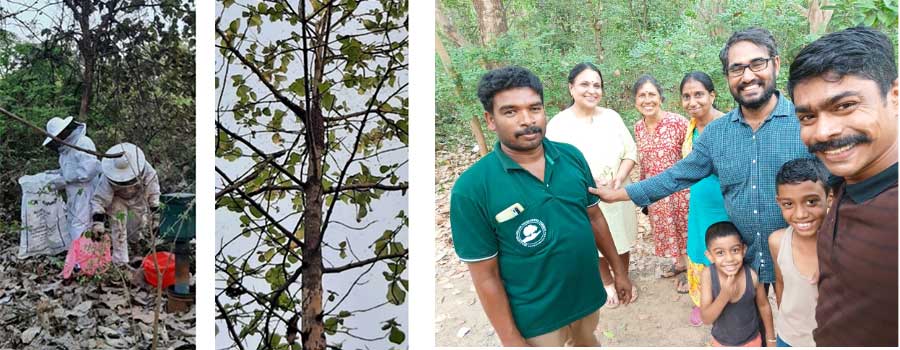
Left: Bees being freed in the forest; Middle: The swarm settles on a tree; Right: The happy crew with the forest manager.
Later we went to a secure wooded area and released the swarm, which sailed up in whirling, pulsating clouds and settled around a tree trunk. A few birds were calling. Dusk was falling. We left the bees and the wood and went our own ways. The swarm was secure and hopefully starting to build their new home.
A good day’s work.
Post script:
I asked Rajendran and Vishnu if they would be willing to share their contact information and answer questions that anyone may have about their operations, background and passion for insects. They graciously agreed. Read on.
About my Interest in Bees and Wasps by T. Rajendran
Bees and wasps may be little insects but plays a very vital role in the ecosystem. They are very good pollinators in the world; ideally they don’t need humans’ help to survive but the human race is completely dependent on them for their existence.
During my childhood I admired my thai mama (term for maternal uncle) who handled dorsata and extracted honey without any special suit and using only smoke. My mom, my aunt, myself and my sister (we are non-identical twins) used to make fire and smoke standing under the coconut tree to divert the bees. He would extract kilograms of honey and we used to take a honey bath as we were standing right under the tree! He did not kill even a single bee as he seamlessly brought the comb in a bucket from the 30/40 ft tall coconut tree. He is my inspiration. From then on, I have had a huge obsession with bees but I was not able to focus much as I was studying my higher education and college while living in a hostel.
I started beekeeping with couple of boxes in the middle of 2016. Since then I propagated to 15 boxes by splitting the existing colonies. That time I was only focused on increasing the hive numbers, not on making money. By the time I reached 20 densely populated hives, COVID pandemic started ruling the world and I was not an exception to the curfews which were placed to restrict the movement from one district to another. Whereas I was in Chennai, my bees were alone in my native (hometown) in the foothills of the Kolli hills. In the close to 3 months due to lack of care, almost all my bee hives absconded due to ant attack, but 2 hives were left and surviving for me to come and rescue. I lost the hope of starting an apiary again when I saw the hives’ condition. I sat silent without any words and didn’t speak for 3-4 hours.
Then Vasanthi (my wife), who was aware of my interest and passion for bees came near me to give me the moral support I so badly needed. I was telling her my dream got scattered and I didn’t know what to do. And I did not have the funds to start the apiary again.
Then she told me one thing: “See people are struggling to find a job for survival but you have well known job (bee keeping) which is your passion as well. You continue what you are doing and initiate the work to start an apiary. I will do the financial help with all my savings.” With her support I brought the 2 hives to Chennai which was all that was left out in my native. From the 2 hives, we expanded to 7 hives in the very first year. And I started TRBees and Apiary [TR Bees and Apiary https://maps.app.goo.gl/M9cNk9xjKe6nYzyb6]. With the support of enthusiastic terrace gardeners and the people who runs acres of farm lands we are now into our 7th year.
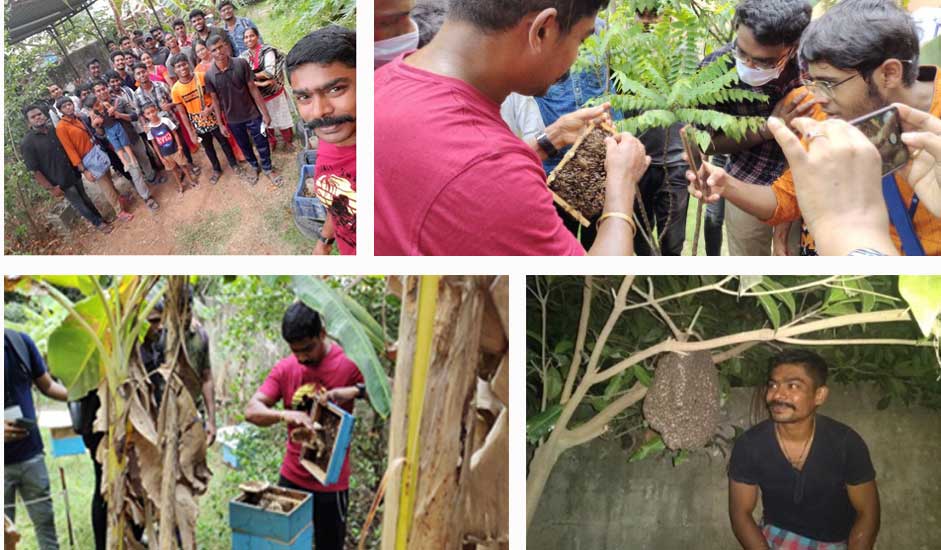 Like bees, wasps also are great pollinators; however people in cities are not able to distinguish bees and wasps. For them whatever flies in the size of bees all are bees
Like bees, wasps also are great pollinators; however people in cities are not able to distinguish bees and wasps. For them whatever flies in the size of bees all are bees 

The thing that keeps on running in my mind is LIVE AND LET LIVE.
Thank you for the opportunity to share my story.
Cheers
RAJENDRAN
Ph: +91-9962591218
Email: rajsrmc@gmail.com
Facebook: https://www.facebook.com/trbees/
Dheeran Live World of Fish and Bees by Vishnu Manoharan
My name is Vishnu Manoharan. My farm is “Dheeran Live World” where I have vast varieties of creatures around me. My home town is a village in Karur district named Chettipalayam, and that is where I was born and brought up. My father was an agriculturist, mother a home-maker. There is a river near our house called the Amaravati. The village was very beautiful those days… one of my father’s elder brothers (called a periappa) used to take me to the river when I was very young to catch fish and rear it in a small cement tank at our house…I believe I inherited my fish interest from him; and not only fish but also other living creatures…
During my childhood, my younger brother, me and cousins used to go to the river where I spent most of the time catching and watching the activities of various varieties of fishes in the river. During my college days I used to practice fish breeding in my aunty’s house back yard. After I finished college (2007) I worked in a private hospital as an internal auditor as I completed a master’s in medical biotechnology course. One fine day I decided to resign, go back to my village and do a business that I liked – fisheries. Many of my relatives and village people advised me to go back to work, but I was strong enough to persevere. I started a tropical aquarium fish hatchery where I breed many varieties of fishes like guppy, molly, platy, American cichlids, bettas, gourami, gold, koi, Malawi cichlid, tetras, etc. One year my fish business was stuck with water scarcity because of drought. I was unable to continue my fish business for which water is vital; for a few months I was unable to do anything except maintaining a few fish varieties.
Around the year 2014, I got a chance to hear about the importance of bees and their nearing extinction because of human activities through one of my relatives. There I found the purpose of my life – a spark to save bees dawned, really not for earning but to save them. I started with 10 bee hives particularly Apis cerana indica although I had not enough experience or prior training but with word-of-mouth guidance. A few months later I found the bee colonies one by one absconding. Unable to do anything, I decided to go to a beekeeping course at Tamil Nadu Agricultural University…I attended courses and practiced again with few bee hives, gaining some experience. A few months later again I went back to the same course with lots of doubt – in the end I went 4 times to the same course, but finally I understood that not only books/courses support us but very importantly our direct personal practical experiences with passion will teach more than anything!
Knowing more and more about bees, my passion towards solitary bees, little bees, stingless bees, Rock bees, Italian bees also increased. I started doing services: rescuing little bees, stingless bees, Indian bees and harvesting honey without damaging their comb as they are soft and timid. I kept on thinking of how to save bees and how to harvest honey without damaging their comb and found ways and methods to take care of them. I brought awareness to the people about the importance of bees through training especially in our farm, colleges, schools, institutions, farmers etc. As of now I have 400 Indian bee colonies at and around my farm. Depending on the season I also harvest varieties of honey such as Leucas aspera honey, teak honey, multi floral honey, neem flower honey, moringa flower honey, beetle nut flower honey, banana flower honey, gingelly flower honey, sunflower honey, etc.
One bad day one of my uncles at our village expired because of a massive bee attack. A few people said it was because of the hornets he died, and others said because of rock bees (Apis dorsata). I went to the spot and found it was because of rock bees. People complained to fire service department, which then exterminated them…and their honey was also wasted. I tried a lot to save them and told the fire service personnel that killing them is not a permanent solution to this man–honey bee encounter, but that the only way is to understand them and know the techniques to escape during attack. I also explained to the fire service personnel the importance of bees to our environment and their cross pollination. That day I decided to find a permanent solution to these bees–human conflicts. I created my ways towards saving rock bees by rescuing them, by chasing them away and by creating job opportunities for youngsters so that people will save them because of direct benefits. Till now I have been rescuing/chasing more than 100 of rock bee colonies and experimenting other ways to save them.
Five years back my interest also turned towards natural agriculture. I wanted to bring awareness to the people about the importance of natural agriculture…most of the living things around us suffer because of pesticides, herbicides and chemicals we use for agriculture. But before I advised others I decided to be true to the process myself.. so I practiced it at our farm producing traditional products such as panja kavya, jeevamirdham, meen amino amilam (fish protein), Agni asthra, mooligai poochi viratti (herbal insect repellent), uta uram, etc. I also was aware of other living organisms such as snakes, predatory insects, birds, wasps, lizards, scorpions, centipedes which are important for the natural ecosystem to maintain. I also started rescuing snakes from houses and leaving them at our farm safely and bringing awareness about the importance of living things around us.
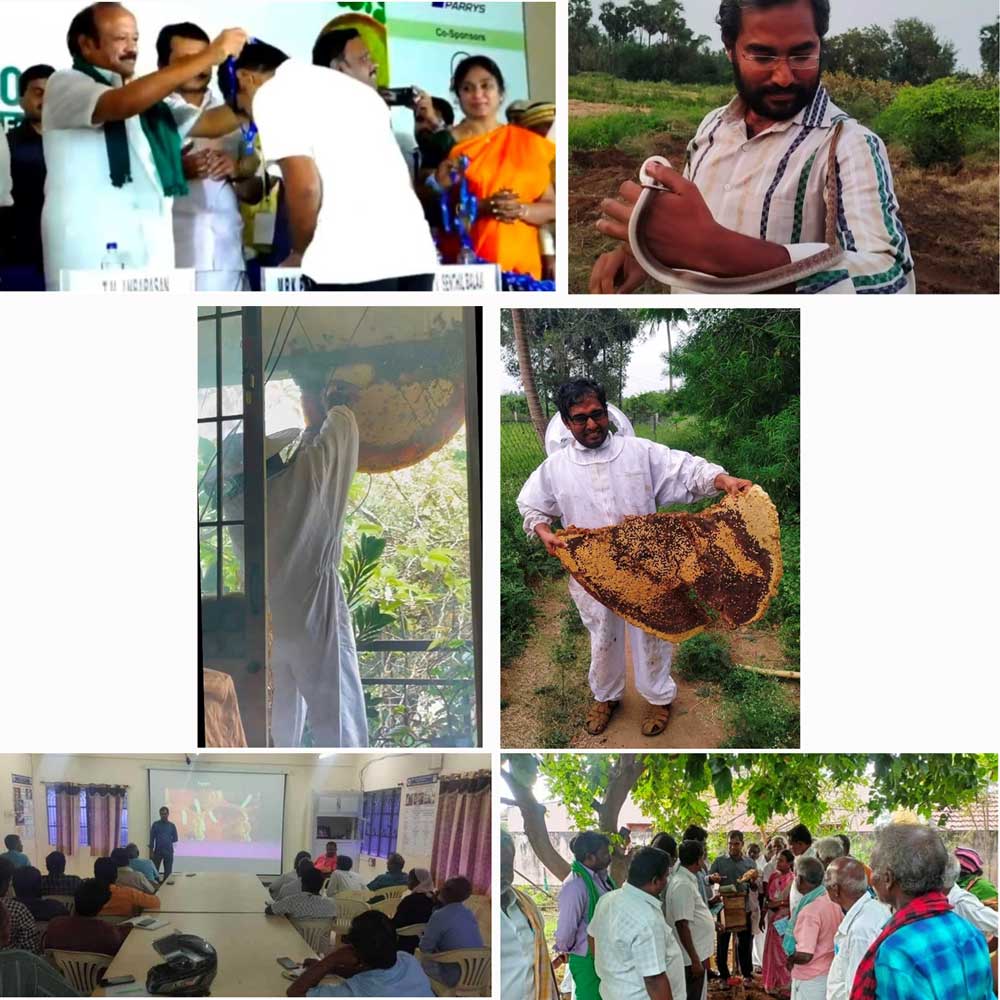 Today I serve as chairman of a company called Karur Velaan collective farming producer Company limited, in which 500 farmers are shareholders. I have been awarded the best farmer award, young farmer award, guardian of bees award and I was also nominated for India’s prestigious Padma awards 2022- 2023. The recognition is helpful to get the word out to save our natural world.
Today I serve as chairman of a company called Karur Velaan collective farming producer Company limited, in which 500 farmers are shareholders. I have been awarded the best farmer award, young farmer award, guardian of bees award and I was also nominated for India’s prestigious Padma awards 2022- 2023. The recognition is helpful to get the word out to save our natural world.
C M Vishnu
Dheeran Live World
Chettipalayam, Appipalayam post
Manmangalam Taluk,
Karur District, Tamil Nadu, India
Contact – 9940392109, 6380702007
Email- dheeranliveworld@gmail.com
YouTube channel- Fully Natural
Postscript: Four days after the bee operation, I met the maintenance supervisor again. He told me that he would like the bee guys’ contact information should the bees come back. He had been sorry to have to spray the first hive. He told me bees were ancient souls and that they deserved to be left alone. He also showed me a small hive of A. florea in a tree outside the apartment block. I realized that he was sharing the general ethos of live and let live that was prevalent in this ancient Indian culture with animistic roots and with a million gods who each had a representative animal. I looked up “Indian god of bees” and Wikipedia popped up Bhramari, goddess of bees, hornets, wasps, spiders, and even mosquitoes (https://en.wikipedia.org/wiki/Bhramari). In mythology, she had unleashed them to defeat a dangerous asura (demon), and had stung, clawed and bitten him to death. Their fearsome reputation was only enhanced, but at least they were overseen by a deity whom it would be unwise to displease..

Bhramari, the Hindu goddess with dominion over six- and eight-legged animals
No doubt they can use all the protection they can get!







